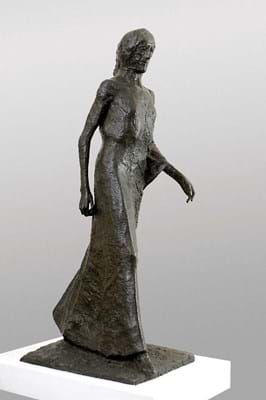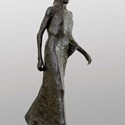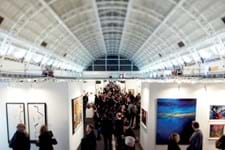JOHANNA or ‘Jo’ Baring speaks about Chris Ingram, media entrepreneur, serial investor and philanthropist, in respectful tones that occasionally give way to indulgence.
“He’s already got lots of Neo- Romantic works,” she says with a slight smile during our meeting in her Oxford Circus office. “Then he sees another Keith Vaughan and says, ‘I know I don’t need it, I know, I know, but I just love it’.”
Baring is curator of the Ingram Collection, widely acknowledged as one of the leading private collections of its kind.
She has held the role since 2013, joining from Christie’s where she was director and head of department for 20th century British art. Calm and composed in person, it’s clear she applies structure to the process of building and circulating the collection, giving shape to Ingram’s zealous approach to owning art.
A selection of Modern British works from the 700+ collection will be exhibited on loan at the London Art Fair this month. As is the case for any of Ingram’s core Mod Brit group, Baring says these treasures are “sacrosanct” in that there is no question of them being sold off now or in the near future.
Rather, Ingram and Baring’s goal with this collection is to inspire a wider audience to become buyers, to borrow or perhaps just to learn.
The collecting bug
When Baring started in 2013, Ingram had been collecting seriously for 12 years, fuelled by selling his business, media group Tempus, in 2001 for a reported £430m.
Today he’s still actively involved in private equity investment, making space for the collecting around his other various business commitments.
“I don’t know where he gets the time,” Baring says. “He’ll go off for the weekend and invoices will appear for things he’s added to the collection. He’s definitely got the bug.”
Baring is responsible for three branches of the Ingram Collection.
The Young Contemporary Talent programme gives a helping hand to emerging artists. The art outreach programme, Inside Out, exhibits art by prisoners and focuses on “using the power of art to ‘unlock’ people” to rebuild self-confidence.
Baring’s art experience particularly supports the third branch, The Ingram Collection of Modern British Art. She started working at Christie’s South Kensington in 2001, around the same time that Ingram began buying art in earnest. Since then, she reflects, the Mod Brit market has changed “beyond recognition”.
“You look back at some of the catalogues we were producing in South Kensington 15 years ago and if you look at what you could buy…” she breaks off and sighs, regretfully.
In 2002, during a Modern art preview at Sotheby’s, Ingram came across several British pieces that appealed to him for their darkness and intensity. A specialist encouraged him, suggesting he could build a great Mod Brit collection for about £1m.
“Obviously it has cost a lot more than that,” Baring says, “but that was the lightbulb moment for him.”
And after all, Ingram was a man with more than a million to spend.
Baring estimates that some 300 paintings, sculpture and installations have been added since she joined. As she talks, she makes casual reference to an impressive list of artists whose works they’ve acquired: Gerald Laing (1936-2011), Geoffrey Clarke (1924-2014), Kenneth Armitage (1916-2002) and Ralph Brown (b.1957), to name a few.
Out on loan
But her role in the collection is as much involved with loaning pieces out – as to London Art Fair – as it is with bringing them in.
The earliest lending project was to The Lightbox, an award-winning public gallery in Woking, Ingram’s hometown – a collaboration that has endured for the gallery’s 10-year history. The gallery first approached Ingram for funding during its construction but as Ingram had recently bought Woking Football Club, he provided art instead of money.
In the early days, Baring says, Ingram got a kick from moving about the gallery and “listening to people’s opinions on the art. He likes seeing people’s reactions, especially when they don’t like it”.
The desire to engage people visually seems to be a holdover from his media career, and the practice of lending out his pieces has persisted.
The majority of his core Mod Brit holding has been exhibited somewhere in the UK at some point.
Today, 154 Mod Brit works from the collection are currently on public display, and most of this core group has been on public show.
The loan process is now effectively part of the collecting strategy, and for Baring the two strands are entwined.
Before an auction, Baring says, she and Ingram “view pieces we like, then work out what we can do with them. There’s no point buying something because it’s an amazing piece of work only to put it in storage.”
After they agree on a piece, Baring does the buying, in part so that Ingram won’t get carried away. She’ll never make an impulse buy, she vows.
Baring says that Ingram, on the other hand, likes telling a story about getting embroiled in a battle over Elisabeth Frink’s Walking Madonna at Sotheby’s and setting a record by underbidding it. Despite staying out of the saleroom, he finds it hard to let go. “I’ll be bidding,” Baring says, “and he’ll be calling me all the time saying ‘did we get it, did we get it?’.”
One of their earliest decisions was the purchase of Ralph Brown’s Meat Porters, a work Baring suggested when Ingram was on the lookout for a piece with “the pow factor” (another legacy of his advertising days is that “Chris loves a catchphrase”, Baring says).
But for the most part a maquette is as likely to join the collection as a sculpture. “We have a complete lack of hierarchy when it comes to buying,” she adds. “If we have a major oil and someone has the watercolour study, we’re all over that.”
Fairs play a big part in the collecting. Every year, Baring and Ingram together hit Frieze and Frieze Masters, 20/21 and, of course, London Art Fair.
Ingram first had the idea several years ago of putting together an in-fair exhibition of works that were on loan to The Lightbox, in part to demonstrate the relationship that can exist between a private collector and a public institution.
Baring hopes it will encourage visitors to invest in Mod Brit art. “It’s not like Old Masters where you have to spend a fortune for museum-quality works. These are works that are hung in museums, but there will also be examples at the fair.”
For those who already collect, it’s a chance to check out other collecting strategies. For Ingram and Baring, seeing the Bowie collection this year was instructive.
“You might expect a celebrity collection to be ‘blingy’ and have all the big names,” she says. “But Bowie collected with a complete lack of hierarchy. It almost conforms to what we’ve been doing ourselves.”
Ingram, she says, tries to buy against fashion and support lesser-known artists. Sometimes bidding on smaller names has proved to be a canny tactic in the long term. Before they rose to prominence during the past few years, Ingram managed to amass an impressive set of works by artists such as William Roberts, 1895- 1980 (18 works) and Edward Burra, 1905-76 (eight works) – pieces other collectors wouldn’t mind getting their hands on.
But Baring is loyal to her community. The only time she gets cagey is when she’s asked to identify the other top collectors active today.
It’s no secret that she and Ingram will head to LAF prepared to buy. Last year they came away from the fair with six drawings by Feliks Topolski, 1907-89 (later in the year the Tate added one of the artist’s large-scale works to its permanent collection).
Whatever the two come away with, however, the works are likely to show up again in public before too long – as is Baring herself as she builds and shares this evolving, intriguing collection.













